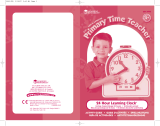Page is loading ...

LER 3209
Multilingual Guide
™
8
+
•
L
e
e
f
t
i
j
d
e
n
•
A
g
e
s
•
Â
g
e
s
•
I
d
a
d
e
s
•
E
d
a
d
e
s
•
A
l
t
e
r

Cube • Cube
Cubo • Würfel
Cubo
Sphere • Sphère
Esfera • Kugel
Esfera
Hemisphere • Hémisphère
Semiesfera • Halbkugel
Hemisfério
Cylinder • Cylindre
Cilindro • Zylinder
Cilindro
Pentagonal prism • Prisme pentagonal
Prisma pentagonal • Fünfeckiges Prisma
Prisma pentagonal
Rectangle prism • Prisme rectangulaire
Prisma rectangular • Rechtwinkliges Prisma
Prisma rectangular
Square pyramid • Pyramide carrée
Pirámide cuadrada • Rechtwinklige Pyramide
Pirâmide quadrangular
Triangle pyramid • Pyramide triangulaire
Pirámide triangular • Dreieckige Pyramide
Pirâmide triangular
Triangle prism • Prisme triangulaire
Prisma triangular • Dreieckiges Prisma
Prisma triangular
Cone • Cône
Cono • Konus
Cone

Introduce concepts of volume relationship between solid shapes with this set
of fourteen large View-Thru™ geometric solids. Use the shapes to estimate,
measure and compare volumes in a small group or demonstration setting.
Volume Estimation
Have students list, from least to greatest, the estimated volume of each solid.
Students should check estimates by calculating the volume or lling each shape
with a graduated cylinder and recording the results beside each listed shape.
Volume Formulas
v – volume r – radius
b – base l – length
w – width h – height
s – side length of base
a – apothem (length from the center of a polygon to one side)
Cube – v = l ³ Sphere – v = (4/3) πr ³
Hemisphere – v = (2/3) πr ³ Cone – v = 1/3 (πr²h)
Cylinder – v = πr²h Rectangle prism – v = lwh
Square pyramid – v = 1/3 (lw) h Triangle pyramid – v = 1/3 (1/2 bh) h
Triangle prism – v = (1/2 bh) h Pentagonal prism – v = 5/2 ash
Terminology of Solid Geometry
base face of a geometric shape; bases of the View-Thru™ geometric solids are
blue
polyhedron solid gures with polygon faces
face polygon surface of a polyhedron; shapes in this set are either at or curved
edge intersection of two faces of a polyhedron where they meet at a line
vertex intersection of three or more faces of a polyhedron where they meet at a
point, or corner
prism polyhedron with two congruent, parallel bases and rectangles for the
remaining faces; named for the shape of its bases
pyramid polyhedron with one base and triangles for the remaining faces; named
for the shape of its bases
cylinder two congruent, parallel circular bases and a single curved, lateral face
sphere the set of all points in space equidistant from a given point called the
center

© Learning Resources, Inc., Vernon Hills, IL (U.S.A.)
Learning Resources Ltd., King’s Lynn, Norfolk (U.K.)
Please retain our address for future reference.
Made in China. LRM3209-GUD
For a dealer near you, call:
(847) 573-8400 (U.S. & Int’l)
(800) 222-3909 (U.S. & Canada)
+44 (0)1553 762276 (U.K. & Europe)
Look for these other great products from
Learning Resources
®
!
LER 1206 Liter Set
LER 1207 Gallon Set
LER 2906 Graduated Cylinder Set
/










